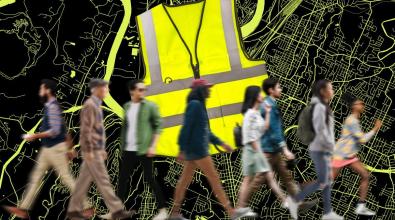 Read More
Read More
3 ways AI can help cities add a human touch to service delivery

Listen to This Article
As cities explore how to employ artificial intelligence in more advanced ways, some of the most promising uses aren’t about public-facing tools like chatbots. Instead, the real breakthroughs may be in finding new ways to use AI to handle some of the most time-consuming tasks that bog down government workers. That’s one focus of Stanford Professor Daniel Ho’s work. He’s partnering with cities like San Francisco to both offload internal tasks to AI and cut down on the number of those tasks altogether, for example by identifying unnecessary reporting rules embedded in city regulations. The goal? Freeing up staff to spend more time on the parts of their jobs that really help residents.
Cities have long struggled with rules and red tape that slow things down. But AI might finally offer a way through.
“Many rules are written with well-meaning goals but fail to solve the problem and create red tape,” Carrie Bishop, who works on the Government Innovation team at Bloomberg Philanthropies and who previously served as San Francisco’s first chief digital services officer, explains. “Reevaluating an entire city code is an overwhelming task that no one has time or appetite to do. With AI's help, the mechanical work is done, leaving a smaller subset of rules so that the hard work of making human decisions can start.”
The following three lessons from Ho’s work offer practical guidance for local leaders interested in realizing this potential.
Inserting AI at key moments to unlock action.
Most city leaders already know about the more common applications of AI. But Ho argues that being more ambitious with the technology doesn’t always mean developing a new “end-to-end solution,” as he describes them. In fact, sometimes, local leaders can achieve massive impact when they insert the technology in a strategic way at a critical point in a complex workflow. And that, in turn, can create space for civil servants to deliver what people need.
For example, as part of a partnership with California’s Santa Clara County, Ho and his team at Stanford RegLab adapted a large language model so it could quickly parse through millions of records. The objective? Identifying property deeds containing discriminatory language that was intended, decades ago, to limit who could purchase certain homes. Doing so manually could consume nearly 10 years of staff time. The new tool did an initial analysis with near-perfect accuracy in just a few days. And while that work still calls for human review, the lesson for Ho is that this sort of approach can help ensure civil servants aren’t so consumed with bureaucracy that they are unavailable for frontline service delivery.
“If you are expending your time on these internal tasks, there are other services that necessarily have to take a hit,” Ho explains. Instead, tools such as this one can help ensure local leaders have capacity to maintain adequate staffing at frontline service counters that provide everything from birth certificates to public benefits.
Creating space for human discretion.
Ho cautions against relying on AI to independently manage some of local government’s most sensitive responsibilities, public benefits chief among them. But even in these complex areas, he argues, AI can play a valuable supporting role by streamlining delivery workflows and freeing up civil servants to focus on the human side of service.
“If we can build systems that make it easier to identify information in a resident’s case file that is relevant to their eligibility for certain forms of assistance,” then you not only improve delivery, Ho argues. “You also free up what might be the most important part, which is the actual resident-city interaction.”
Take housing benefits, for example. When staff spend less time processing paperwork, they have more time to listen, problem-solve, and respond to residents’ broader needs.
“There is still a critical need to have human beings who actually help explain and engage citizens who are interacting with these systems,” Ho says.
Triggering conversations about how to improve policies.
Ho’s work isn’t only showing how cities can free teams from red-tape tasks. It’s also demonstrating how cities can get to the root of those problems: by improving over-complicated policies and programs for the long term.
As part of his team’s collaboration focused on San Francisco’s municipal code, the city has been using a search system developed by RegLab to identify every case where legislation requires agency personnel to produce potentially time-consuming reports. Some of the findings would be comical if they weren’t in danger of using precious capacity, such as the rule calling for regular updates on the state of city newspaper racks that no longer exist.
The ultimate objective is a strategic one: making the case for legislation that eliminates unnecessary requirements. AI’s value in this instance is serving as a tool to help start the conversations needed between city leaders, civil servants, and local lawmakers to change how the city works.
“Highlighting rules that don't make sense or are contradictory should force policymakers to evaluate their policy intent, question whether the rules are helping meet the objective, and discuss changes with the right stakeholders,” explains Bloomberg Philanthropies’ Bishop.
Next steps for this work, Ho says, might include using AI to produce a sort of scorecard for proposed legislation assessing how much administrative effort a new law would actually require to implement. Another possible use case: mapping all the fees collected by a city to determine if they’re costing more to collect than they’re producing in revenue—and, critically, if old fees are consistent with current leadership’s priorities.
Of course, local leaders will continue to develop AI solutions that, in and of themselves, provide tangible improvements to people’s lives. But as Ho emphasizes and the above examples demonstrate, some of the most transformative uses of AI may be less visible. These quieter interventions can reshape the systems behind service delivery, freeing up time, aligning policies with values, and improving how government works at its core.

